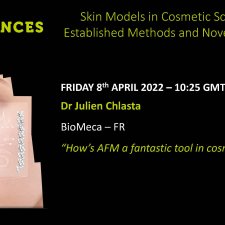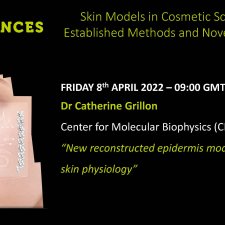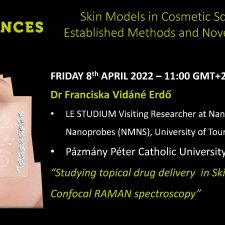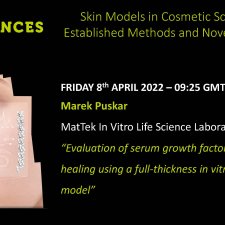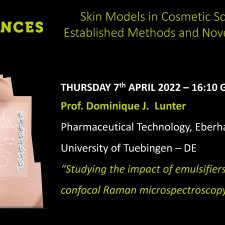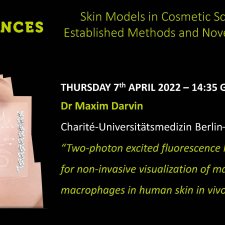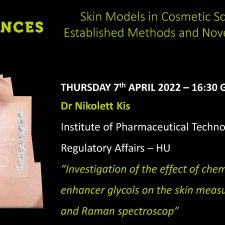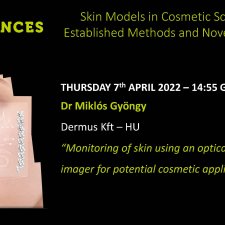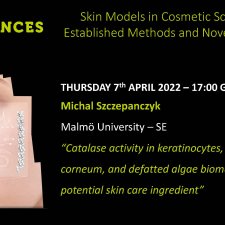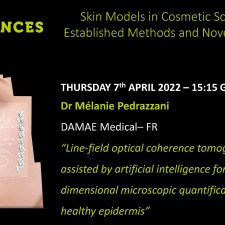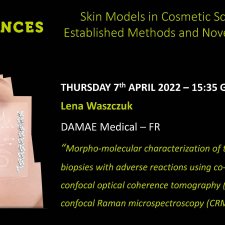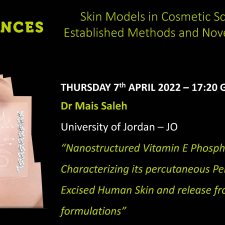Notice
Dr Silvia Letasiova - In vitro skin irritation tests using reconctructed epidermis tissue model, EpiDerm, for evalution of safety and efficacy testing of cosmetics.
- document 1 document 2 document 3
- niveau 1 niveau 2 niveau 3
Descriptif
The EpiDerm 3D human tissue model is used across a diverse range of applications including safety and risk assessment, and biological efficacy. Simple protocols and the evaluation of early cellular endpoints allow research to acquire data in few days. EpiDerm, a Reconstructed Human Epidermis, is a ready-to-use, highly differentiated 3D tissue model consisting of normal, human-derived epidermal keratinocytes cultured on specially prepared tissue culture inserts Cultured at the air-liquid interface, EpiDerm allows for the evaluation of topically applied compounds, chemicals, cosmetic/personal care product ingredients and final formulations. With multiple ECVAM validations and OECD accepted test guidelines, EpiDerm is a proven in vitro model system for chemical, pharmaceutical, cosmetics and skin care product testing. EpiDerm skin irritation test (SIT) is validated and accepted as OECD TG 439. EpiDerm Time-to-Toxicity assay (ET-50 assay) is used for screening, ranking and benchmarking of ingredients, for skin tolerance testing of final products (mildness testing) and for evaluation of minor changes in the formulations. This model can be used for different testing purposes, such as EpiDerm skin corrosion test (SCT), EpiDerm phototoxicity test, etc.
The presentation will provide an overview of the in vitro skin irritation tests using reconstructed epidermis tissue model, EpiDerm, for evaluation of safety and efficacy of cosmetics.
Thème
Dans la même collection
-
Dr Julien Chlasta - How’s AFM a fantastic tool in cosmetic research?
Atomic force microscopy (AFM) is a tool for nanoscale analysis-based approach allowing to obtain mechanical information about structures
-
Dr Catherine Grillon - New reconstructed epidermis models closer to skin physiology
Among skin models, reconstructed human epidermis are largely used in cosmetic domain either to evaluate compounds activity or for regulatory tests such as toxicity. They represent a good alternative
-
Dr Franciska Erdo - Studying topical drug delivery in Skin-on-a-chip and by Confocal RAMAN spectros…
Studying skin composition and interaction with topical substances is important both in dermatology and cosmetoscience. Several techniques are utilized and are under development for these purposes.
-
Marek Puskar - Evaluation of serum growth factors in wound healing using a full-thickness in vitro …
Following skin injury, damaged tissue undergoes highly coordinated biological events to restore barrier function involving cross-talk between dermal fibroblasts and epidermal keratinocytes as well as
-
Prof. Dominique J. Lunter - Studying the impact of emulsifiers on SC lipids by confocal Raman micr…
Emulsifiers are widely used in face washes, shower gels, body lotions and many more cosmetic and pharmaceutic products. Some of them are suspected to show irritating effects and to harm the skin
-
Dr Maxim Darvin - Two-photon excited fluorescence lifetime imaging for non-invasive visualization …
Mast cells (MCs) and macrophages (ΜΦs) are important multifunctional immune cells found in all tissues of the body. In the skin, resting and activated MC populations and M1- and M2-polarized ΜΦs are
-
Dr Nikolett Kis - Investigation of the effect of chemical permeation enhancer glycols on the skin m…
Dermal drug delivery is an attractive alternative to conventional drug administration due to its advantages.
-
Dr Miklós Gyöngy - Monitoring of skin using an optical-ultrasound imager for potential cosmetic app…
Optical-ultrasound imaging is a cost-effective method of simultaneously imaging the skin surface and the region under the surface.
-
Michal Szczepanczyk - Catalase activity in keratinocytes, stratum corneum, and defatted algae bioma…
Catalase is one of the most important antioxidative enzymes. Its main function is the decomposition of hydrogen peroxide belonging to the group of reactive oxygen species.
-
Dr Mélanie Pedrazzani - Line-field optical coherence tomography (LC-OCT) assisted by artificial int…
Line-field confocal optical coherence tomography (LC-OCT) is an optical technique based on a combination of confocal microscopy and optical coherence tomography, allowing three-dimensional (3D)
-
Lena Waszczuk - Morpho-molecular characterization of tattooed skin biopsies with adverse reactions …
Line-field confocal optical coherence tomography (LC-OCT) is a non-invasive optical technique for imaging the skin at high resolution (∼ 1 μm), based on a combination of OCT and reflectance confocal
-
Dr Mais Saleh - Nanostructured Vitamin E Phosphate: Characterizing its percutaneous Penetration int…
Modern topical sunscreens combine topical antioxidants with physical UV filters to achieve optimal skin protection1–3. α-Tocopherol phosphate (α-TP), a new pro-vitamin E antioxidant, prevents UVA1

